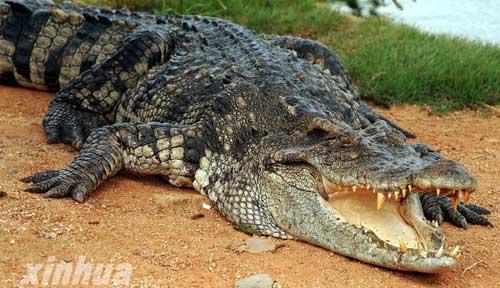
鳄鱼拥有较强的免疫力,能够防止鳄鱼在险恶环境下,与掠夺者搏斗后留下的伤痕产生致命感染。曾有科学家们发现鳄鱼强大的免疫系统可以杀灭艾滋病毒(HIV),研究人员发现鳄鱼血液中所含的某些蛋白质能够杀死对盘尼西林有抗药性的细菌,例如金黄葡萄球菌[1]。
鳄鱼的心脏和人类一样有心房(左心房、右心房)和两室(左心室、右心室),是脊椎动物中首次出现的左右心室完全分隔。(两栖动物和除鳄鱼以外的爬行动物都只有一个心室,或没有完全分隔的左右心室。)脊椎动物中只有鳄鱼、鸟类、哺乳动物有左右心室完全分隔的心脏。
鱷魚壽命多在45-100年的範圍間,平均為75年。根據部分考古學家研究發現,古代鱷魚體長最長達到12米。
鳄鱼是一种曾经和恐龙同时存在的动物,但超强的适应力使它存活至今。
Crocodiles (subfamily Crocodylinae) or true crocodiles are large aquatic reptiles that live throughout the tropics in Africa, Asia, the Americas and Australia. Crocodylinae, all of whose members are considered true crocodiles, is classified as a biological subfamily. A broader sense of the term crocodile, Crocodylidae that includes Tomistoma, is not used in this article. The term crocodile here applies only to the species within the subfamily of Crocodylinae. The term is sometimes used even more loosely to include all extant members of the order Crocodilia, which includes Tomistoma, the alligators and caimans (family Alligatoridae), the gharials(family Gavialidae), and all other living and fossil Crocodylomorpha.
Although they appear to be similar to the untrained eye, crocodiles, alligators and the gharial belong to separate biological families. The gharial having a narrow snoutis easier to distinguish, while morphological differences are more difficult to spot in crocodiles and alligators. The most obvious external differences are visible in the head with crocodiles having narrower and longer heads, with a more V-shaped than a U-shaped snout compared to alligators and caimans. Another obvious trait is the upper and lower jaws of the crocodiles are the same width, and teeth in the lower jaw fall along the edge or outside the upper jaw when the mouth is closed; therefore all teeth are visible unlike an alligator; which possesses small depressions in the upper jaw where the lower teeth fit into. Also when the crocodile's mouth is closed, the large fourth tooth in the lower jaw fits into a constriction in the upper jaw. For hard-to-distinguish specimens, the protruding tooth is the most reliable feature to define the family that the species belongs to.[1] Crocodiles have more webbing on the toes of the hind feet and can better tolerate saltwater due to specialized salt glands for filtering out salt, which are present but non-functioning in alligators. Another trait that separates crocodiles from other crocodilians is their much higher levels ofaggression.[2]
Crocodile size, morphology, behavior and ecology somewhat differs between species. However, they have many similarities in these areas as well. All crocodiles aresemiaquatic and tend to congregate in freshwater habitats such as rivers, lakes, wetlands and sometimes in brackish water and saltwater. They are carnivorousanimals, feeding mostly on vertebrates such as fish, reptiles, birds and mammals, and sometimes on invertebrates such as molluscs and crustaceans, depending on species and age. All crocodiles are tropical species that unlike alligators, are very sensitive to cold. They first separated from other crocodilians during the Eoceneepoch, about 55 million years ago.[3] Many species are at the risk of extinction, some being classified as critically endangered.
No comments:
Post a Comment